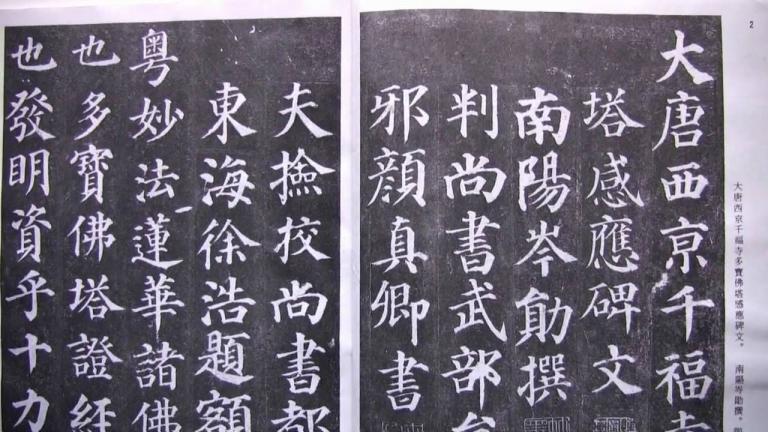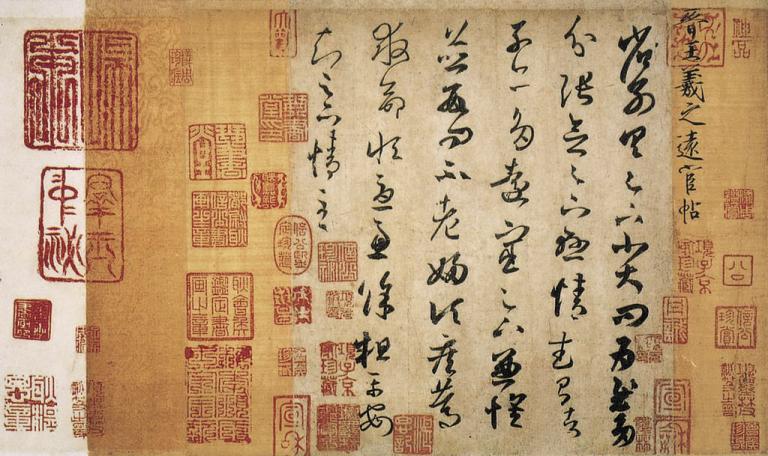Highly Influential “Four Masters of the Early Tang Dynasty”
5 min readIn the early Tang dynasty, the political system followed that of the Sui dynasty. In Zhenguan period (627-649, the whole nation began to prosper with rectitude government, stable society, thriving economy and flourishing culture. And calligraphy also entered a new phase of development. Emperor Taizong of the Tang dynasty, Li Shimin, was fond of calligraphy. He was good at semi-cursive script and hollow-stroke script. With all officials followin the emperor, calligraphy developed vigorously in that period.

The Four Masters of the Early Tang Dynasty, namely, Ouyang Xun, Yu Shinan, Chu Suiliang and Xue Ji, made great contributions to this development by completing the transition from verve centric Jin calligraphy to rule-driven Tang calligraphy. Ouyang Xun (557-641), courtesy name (zi) Xinben, was born in Linxiang, Tanzhou (now Changsha, in Hunan). He used to be an official in the Sui dynasty and was a close friend to Li Yuan, founder of the Tang dynasty. Ouyang Xun was intelligent since very young and very knowledgable on poetry anthology and history. His calligraphy was first influenced by the style of stele inscriptions in the Northern Dynasties and the Sui dynasty.
Later he followed Wang Xizhi and Wang Xianzhi’s style and was the representative for their style in the Tang dynasty. He had also learned from Suo Jing’s calligraphy. yang Xun was good at all styles of calligraphy, especially at regular script the strong and severe characteristics that could be seen in Suo Jing’s works and stele inscriptions of the Northern Wei dynasty. The new style he created was known as “Ou Style”. Besides, his semi-cursive script was also splendid. His works were outstanding calligraphic model with advantages of calligraphy from both the south and the north. He had made great contribution to the development of regular script in the Tang dynasty. His works that can be seen today include rubbing books and inscriptions.
His son named Ouyang Tong, inherited his talent in calligraphy and left us with Stele Inscription for Master Daoyin and Epitaph for Quan Nansheng. Yu Shinan (558638), courtesy name (zi) Boshi, was born in Yuezhou (now Yuyao, in Zhejiang). Had learned calligraphy from Zhi Yong and taken in the essence of Wan of calligraphy in southern China. Steady and with strength, upright and elegant, some of his works were really free and rakish As Emperor Taizong thought high of Wang Xizhi’s aesthetic taste and concept, Yu’s calligraphy was also Taizong’s favorite and his style greatly influenced Taizong’s calligraphy. One of his famous calligraphic works is Stele Inscription in the Confucius Temple. Yu’s calligraphy influenced his successors a lot. Lu Jianzhi, his nephew was one of the successors that even surpassed his uncle’s accomplishment. Lu Jianzhi had the same reputation as Ouyang Xun and Chu Suiliang before Xue Ji surpassed him. Another amo famous calligrapher Yan Zhenqing even mentioned Yu Shinan and Lu Jianzhi’s name together, which revealed that Lu’s calligraphy was also greatly appreciated by people at that time.
Chu Suiliang (596-659), courtesy name (zi) Dengshan, was either from Qiantang (now Hangzhou, Zhejiang or Yangdi now Yuzhou, in Henan). His father Chu Liang used to be an official in Chen of the Southern Dynasties and was in charge of court proprieties in the Sui dynasty together with Ouyang Xun. He provided a good condition for his son to learn calligraphy. Chu Suiliang was able to learn from different styles and took the advantage to create his own style. According to the history, he had learned from Ouyang Xun, Yu calligraphy. His calligraphy was known as “Chu Style Calligraphy” and he was listed as one of the four greatest regular script calligraphers in the early Tang dynasty Chu’s calligraphic style was thin and rigid, yet with free and classic elegance The unique characteristic was blending some traits of clerical script into regular script. In his calligraphy, though all strokes were sparse and thin, the structure was upright and with classic elegance. One of his works was produced when he was years old and the original calligraphy was found in nowhere. Luckily there was a single rubbing book left from the Tang dynasty Though it is difficult to tell whether it was authentic or not, it did reveal Chu Suiliang’s calligraphic style. So Chu’s followers all practiced calligraphy according to the copy of this rubbing book. Besides the rubbing book, Chu’s calligraphy can also be appreciated from so me stele inscriptions like Notes for Yinque Buddhist Niche, Stele Inscription for Master Meng and Preface for Sacred Instruction in the Tower of Wild Goose.
Xue Ji (649-713), courtesy name (zi) Sitong, was born in an intellectuals’ family in Puzhou, Fenyang (now Wangrong county, in Shanxi) He had successful official career and was invested with the honor as the Duke of Jin. Unfortunately, in 713, during Emperor Xuanzong’s reign, he was embroiled into the case of Dou Huazhen and was ordered to kill himself in prison Xue was the grandson of Wei Zheng, a chancellery with high reputation in Emperor Taizong’s period. He had watched many calligraphic works produced by Yu Shinan and Chu Suiliang in his grandfather’s house and was inspired to practice calligraphy During that period he was most influenced by Chu Suiliang’s calligraphy. Later when he served in the inner court, he also gained the opportunity to learn from works of many famous calligraphers from Wei and Jin dynasties like Zhong Yao, Zhang Xu, Wang Xizhi and Wang Xianzhi. So his calligraphy had also taken in some classic style. Though as the last of the four greatest regular script calligraphers in the early Tang dynasty, Xue left few calligraphi works. From his only work left in small regular script, we can see one of the characteristics of the early Tang regular script: thin and rigid.
However, Xue seemed to emphasize too much of that feature and lost the fleshy beauty of calligraphy Xue Ji had great influence on Liu Gongquan in the late Tang dynasty and Zhao Ji in the Northern Song dynasty Ouyang Xun, Yu Shinan, Chu Suiliang and Xue Ji are known as the “Four Masters of the Early Tang Dynasty”, also called “Representatives of Early Tang Calligraphy”. Their works were models of the Tang calligraphy in brush using techniques and stroke writing rules. Among the four, Ouyang Xun and Yu Shinan created their new styles and developed the art of Chinese calligraphy into a new level; hence they had profounder effect on later calligraphers.









